Cut-leaf crabapple facts for kids
Quick facts for kids Cut-leaf crabapple |
|
|---|---|
 |
|
| Conservation status | |
| Scientific classification |
Malus transitoria, also known as the cut-leaf crabapple, is a beautiful species of flowering plant. It belongs to the crabapple family, called Rosaceae. This tree originally comes from China.
The name transitoria comes from Latin and means "short-lived." The "cut-leaf" part of its name describes its unique leaves.
Meet the Cut-Leaf Crabapple Tree
The cut-leaf crabapple is a deciduous tree. This means it loses its leaves every autumn. It can grow up to 8 meters (about 26 feet) tall. It can also spread out about 10 meters (about 33 feet) wide.
Its leaves are deeply divided, almost like they are cut. In autumn, these leaves turn a bright yellow color. The tree produces many white flowers. It also grows small yellow fruits. These fruits are about 8 millimeters (0.3 inches) across.
Different Types of Cut-Leaf Crabapple
There are a few different types, or varieties, of the cut-leaf crabapple. These types have slight differences in how they look or grow.
Why Do People Grow This Tree?
People often grow the cut-leaf crabapple as an ornamental tree. This means it is grown for its beauty. It has a lovely shape, many white flowers, and pretty yellow fruits.
This tree is so beautiful that it won the Royal Horticultural Society's Award of Garden Merit. This award shows it is an excellent plant for gardens. The cut-leaf crabapple is also used as rootstock for other apple trees. This means its roots are used to help other apple trees grow.



